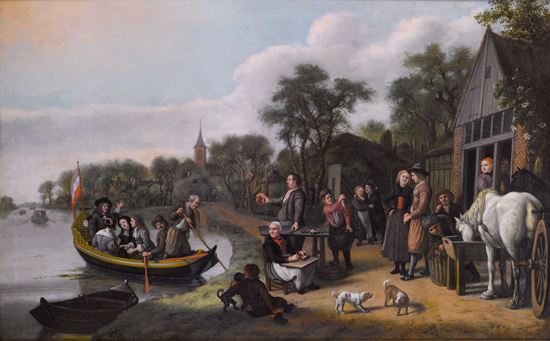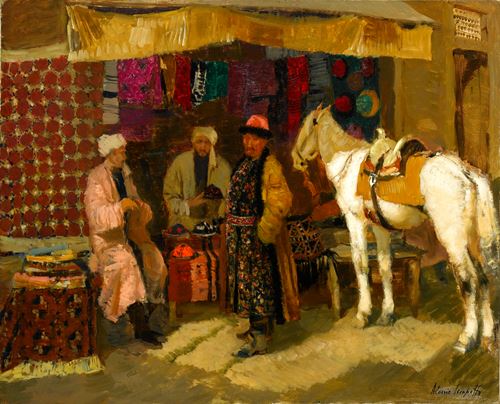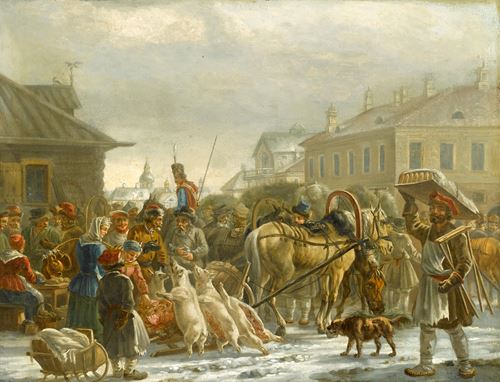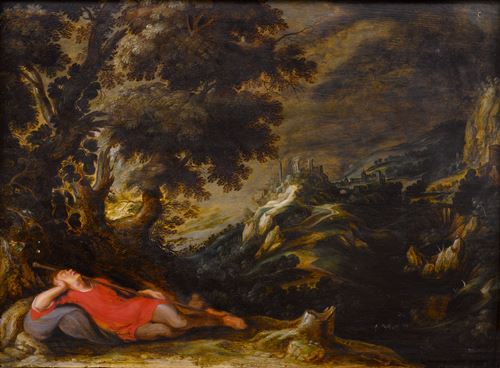an Victors
(Amsterdam 1619 - East Indies 1676)
Town Folk Coming to the Country
signed on the boat ‘Jan Victors’ (lower left)
oil on canvas
100 x 156 cm (39⅜ x 61⅜ in)
In this charming genre scene Jan Victors depicts the jovial community spirit of Dutch rural life. On the banks of a river villagers merrily go about the day’s business. An old lady sits on a low seat, a chopping board on her knees, about to start gutting the fish which the young boy is laying out on the table. A youthful couple look into each other’s eyes smiling coyly and beyond them another couple appear to be boisterously playing together. Beyond the trough, at which the cart-horses drink, an older figure crouches down, ready to lift the heavily laden wicker basket, watched by the man relaxing with his pipe. Two puppies play together in the foreground whilst a third amuses a young boy. The painting presents a harmonious and happy vision of village life.
Approaching this scene is a river taxi in which there are four city-dwellers who provide a striking contrast to their rural counterparts. The townsfolk are formally dressed in sober yet elegant costumes, the gentlemen wearing fashionable wigs. They are deep in earnest conversation and two of the figures look concerned whilst another gestures in exasperation. Their pale faces accord with their serious demeanours. The rustic figures, however, appear very different in both appearance and mood. The villager who welcomes the visitors is stocky and portly, his shirt is unbuttoned and his jacket grubby. This is a man whose relaxed demeanour, like that of his fellow villagers, suggests that he enjoys life more openly than his solemn urban counterparts.
Town Folk Coming to the Country is comparable with some of Victors’ most notable genre scenes, such as the Hermitage’s Ferry-Boat. Once more, Victors has painted a typical scene of rural life within the same type of riverside village. To a modern viewer the ferryboat itself is particularly eye-catching because it carries a peasant and his cattle, so that the huge bulk of a cow stands uneasily in such a small and lightweight craft. The indifferent attitude of the peasant, who leans on the cow, sheep surrounding his feet, indicates that this trip is an everyday necessity. In another boat on the left-hand side a boy teases the ducks in the water’s shallows, much to the amusement of his companion. In a similar manner to the way in which Victors contrasts the elegant formality of the townsfolk to the humble earthiness of the villagers in the present work, the Hermitage’s work contrasts the peasants with the horseman on the right-hand side. This man, probably a soldier, is fashionably dressed and groomed, and his horse looks strong and sleek. The peasants, in comparison, wear grubby and worn clothing and the cow looks thin and slightly ungainly. In both works Victors depicts and contrasts two different aspects of contemporary Dutch society.
Both Town Folk Coming to the Country and Ferry-Boat depict contented scenes of day-to-day rural living in similar river-side villages. However, within the genial overall mood of the scenes they both are populated by highly individualised figures, in a manner typical of Victors’ work. Each figure is very deliberately unique, their reactions and moods clearly portrayed by Victors, so that these apparently simple genre scenes are carefully crafted and prove to be diverting and engaging.
Interestingly, Ferry-Boat came to the Hermitage from Marly Palace in 1882. Marly Palace was built by Peter the Great (1672-1725) as an intimate and quiet retreat in the grounds of the Grand Palace at Peterhof. On Peter’s death Marly Palace ceased to be used as a residence and was instead used to store the deceased emperor’s personal possessions, including his wardrobe, official gifts, and various pieces of furniture and art. It seems likely, therefore, that Ferry-Boat, which is so comparable to the present work, was considered to be one of these personal possessions.
Victors was a versatile artist but genre scenes of this type recur throughout his career, another example being the Rijksmuseum’s The Swine Butcher. Rather than the fishing scene that is depicted in the present work, Victors here focuses on the village butcher, who is carving up a freshly slaughtered hog. He has paused momentarily to refresh himself with a well-earned glass of beer which has been brought out to him by his wife. Once more there is a cheerful mood to the painting, underlined by the bright sunshine and the young worker on the left-hand side who shares a joke with the maid. As in the present work, the figures are diverting and interesting, none more so than the child who sits on a barrel as he blows up a pig’s bladder. Both paintings share thematic and stylistic qualities.
Although there is no documentary proof on stylistic grounds, it has long been believed that Victors was a member of Rembrandt van Rijn’s (1606-1669) studio during the second half of the 1630s.¹ As already mentioned, Victors’ work was extremely varied and he depicted many biblical subjects, which in particular illustrate Rembrandt’s influence. During the time when Victors is thought to have been apprenticed, Rembrandt was working ‘on a number of history paintings with large figures who act in striking proximity to the viewer’, such as Belshazzar’s Feast, (National Gallery, London) and his master’s influence can be seen in works such as Victors’ The Anointing of David, which hangs in the Hermitage.² Rembrandt’s work can clearly be seen as the origin of Victors’ close-up view of biblical narratives, where the space between the figures and the viewer is compressed thereby helping to make the scene more engaging. Victors does this still further by depicting the edge of a wooden platform in the forefront of his scene and this further engages the viewer with the pictorial space. Both Belshazzar’s Feast and The Anointing of David also demonstrate an interest in the exotic and in depicting a variety of textures. Simon Schama states that Rembrandt’s students, including Victors, ‘were all quick to pick up the skills of rendering textures of both fabric and precious metals’.³ The theatricality with which Rembrandt imbued his work can also be seen, to an extent, in other works by Victors, including Town Folk Coming to the Country, which possess such clarity of gesture and expression, the group of town folk being a perfect example. His style also shows the influence, both thematic and formal, of his contemporaries in Rembrandt’s workshop, including Govaert Flinck (1615-1660), Ferdinand Bol (1616-1680) and Gerbrandt van den Eeckhout (1621-1674).
Victors was born in June 1619, into the poor family of a carpenter. He was one of ten children and was also half-brother to the bird painter Jacobus Victors (?1640-1705) and the noted Delft potter Victor Victors (b.1638). Having trained with Rembrandt, he seems to have embarked on an independent career in the early 1640s. In this early part of his career Victors established a firmly controlled manner of figure painting in his portraits and historical scenes. Such works as the Young Woman at an Open Window (Louvre, Paris) demonstrate a linear definition of form, sturdy three-dimensional figures and strong Baroque lighting. However, Victors’ middle years were his most productive, and from 1646 to 1655, he produced his most accomplished works. His light-filled compositions became increasingly vibrant and frequently included more subsidiary figures, animated gestures, agitated drapery and atmospheric effects.
In his grandiose and eloquent portrayals of biblical subjects, Victors most often drew from the Old Testament. Within the scope of the scriptures, he chose to portray multifigural and often quite obscure episodes, as his Calvinist audience were much better versed in the Bible than the modern viewer. He also seems to have selected many of these scenes for their didactic potential. It is interesting to note that because he was a strict Calvinist ‘to keep the commandment against graven or idolatrous imagery, Victors refrained from depicting God and avoided representations of Christ’.⁴
It was in this middle period that Victors expanded his thematic repertory to include genre subjects depicting a variety of rustic types and provincial activities, Town Folk Coming to the Country offers an excellent example. These paintings demonstrate affinities with the genre production of artists such as Jan Miense Molenaer (c.1610-1668), Govaert Camphuyzen (1623/4-1672) and Hendrick Sorgh (c.1609-1670). Molenaer’s Tavern of the Crescent Moon, (Museum of Fine Arts, Budapest) for instance, has similar themes to the present work. There is an upbeat atmosphere to the village celebration, their enjoyment reflected in the bright sunlight that bathes the scene. Many of the figures laugh and joke together, there is an abundance of food and there are villagers of all ages. The sense of a happy rural community is one also present in Victors’ work and there is a similar variety of engaging figures to study, such as the man playing with a dog, or the figure greedily tearing the bread in the middle of the table. Molenaer’s work is less accomplished and sophisticated than Town Folk Coming to the Country, but both create a similar impression of an idealised rural life.
In these genre scenes Victors often used the same models for different works, for instance the central figure in The Swine Butcher is repeated in the National Gallery’s A Village Scene with Cobbler. After the mid-1650s Victors became less prolific, eventually abandoning painting to become a ziekentrooster (‘comforter of the sick’) in the service of the Dutch East India Company. His late work is more in keeping with the contemporary Dutch vogue for mannered aesthetics and schematisation.
Victors is last documented in Amsterdam in January 1676. Shortly thereafter he departed for the East Indies and is reported to have died there of unspecified causes. A son, Victor Victors (b.1653), one of nine children, had travelled to the East and was recorded in Australia in 1696-1697, as a ziekentrooster, draughtsman and cartographer with the Dutch East India Company.
¹ Miller, D., ‘Jan Victors (1619-1676)’, 2 Vols, PhD. Diss, (University of Delaware, 1985.)
² Brown, C., Kelch, J. & van Thiel, P., Rembrandt: The Master & his Workshop, (Yale University Press, 1991), p. 336.
³ Schama, S., Rembrandt’s Eyes, (Penguin Books, 2000), p. 519.
⁴ Zell, M., Reframing Rembrandt, (University of California Press, Berkeley, 2008), p. 31.
with A. V. Scully, London, 1927.
Debra Miller, Jan Victors 1619-1676, Phd dissertation, University of Delaware, 1985, vol. I, p.328, no 145, vol. II, p. 470 (illustrated).
In this charming genre scene Jan Victors depicts the jovial community spirit of Dutch rural life. On the banks of a river villagers merrily go about the day’s business. An old lady sits on a low seat, a chopping board on her knees, about to start gutting the fish which the young boy is laying out on the table. A youthful couple look into each other’s eyes smiling coyly and beyond them another couple appear to be boisterously playing together. Beyond the trough, at which the cart-horses drink, an older figure crouches down, ready to lift the heavily laden wicker basket, watched by the man relaxing with his pipe. Two puppies play together in the foreground whilst a third amuses a young boy. The painting presents a harmonious and happy vision of village life.
Approaching this scene is a river taxi in which there are four city-dwellers who provide a striking contrast to their rural counterparts. The townsfolk are formally dressed in sober yet elegant costumes, the gentlemen wearing fashionable wigs. They are deep in earnest conversation and two of the figures look concerned whilst another gestures in exasperation. Their pale faces accord with their serious demeanours. The rustic figures, however, appear very different in both appearance and mood. The villager who welcomes the visitors is stocky and portly, his shirt is unbuttoned and his jacket grubby. This is a man whose relaxed demeanour, like that of his fellow villagers, suggests that he enjoys life more openly than his solemn urban counterparts.
Town Folk Coming to the Country is comparable with some of Victors’ most notable genre scenes, such as the Hermitage’s Ferry-Boat. Once more, Victors has painted a typical scene of rural life within the same type of riverside village. To a modern viewer the ferryboat itself is particularly eye-catching because it carries a peasant and his cattle, so that the huge bulk of a cow stands uneasily in such a small and lightweight craft. The indifferent attitude of the peasant, who leans on the cow, sheep surrounding his feet, indicates that this trip is an everyday necessity. In another boat on the left-hand side a boy teases the ducks in the water’s shallows, much to the amusement of his companion. In a similar manner to the way in which Victors contrasts the elegant formality of the townsfolk to the humble earthiness of the villagers in the present work, the Hermitage’s work contrasts the peasants with the horseman on the right-hand side. This man, probably a soldier, is fashionably dressed and groomed, and his horse looks strong and sleek. The peasants, in comparison, wear grubby and worn clothing and the cow looks thin and slightly ungainly. In both works Victors depicts and contrasts two different aspects of contemporary Dutch society.
Both Town Folk Coming to the Country and Ferry-Boat depict contented scenes of day-to-day rural living in similar river-side villages. However, within the genial overall mood of the scenes they both are populated by highly individualised figures, in a manner typical of Victors’ work. Each figure is very deliberately unique, their reactions and moods clearly portrayed by Victors, so that these apparently simple genre scenes are carefully crafted and prove to be diverting and engaging.
Interestingly, Ferry-Boat came to the Hermitage from Marly Palace in 1882. Marly Palace was built by Peter the Great (1672-1725) as an intimate and quiet retreat in the grounds of the Grand Palace at Peterhof. On Peter’s death Marly Palace ceased to be used as a residence and was instead used to store the deceased emperor’s personal possessions, including his wardrobe, official gifts, and various pieces of furniture and art. It seems likely, therefore, that Ferry-Boat, which is so comparable to the present work, was considered to be one of these personal possessions.
Victors was a versatile artist but genre scenes of this type recur throughout his career, another example being the Rijksmuseum’s The Swine Butcher. Rather than the fishing scene that is depicted in the present work, Victors here focuses on the village butcher, who is carving up a freshly slaughtered hog. He has paused momentarily to refresh himself with a well-earned glass of beer which has been brought out to him by his wife. Once more there is a cheerful mood to the painting, underlined by the bright sunshine and the young worker on the left-hand side who shares a joke with the maid. As in the present work, the figures are diverting and interesting, none more so than the child who sits on a barrel as he blows up a pig’s bladder. Both paintings share thematic and stylistic qualities.
Although there is no documentary proof on stylistic grounds, it has long been believed that Victors was a member of Rembrandt van Rijn’s (1606-1669) studio during the second half of the 1630s.¹ As already mentioned, Victors’ work was extremely varied and he depicted many biblical subjects, which in particular illustrate Rembrandt’s influence. During the time when Victors is thought to have been apprenticed, Rembrandt was working ‘on a number of history paintings with large figures who act in striking proximity to the viewer’, such as Belshazzar’s Feast, (National Gallery, London) and his master’s influence can be seen in works such as Victors’ The Anointing of David, which hangs in the Hermitage.² Rembrandt’s work can clearly be seen as the origin of Victors’ close-up view of biblical narratives, where the space between the figures and the viewer is compressed thereby helping to make the scene more engaging. Victors does this still further by depicting the edge of a wooden platform in the forefront of his scene and this further engages the viewer with the pictorial space. Both Belshazzar’s Feast and The Anointing of David also demonstrate an interest in the exotic and in depicting a variety of textures. Simon Schama states that Rembrandt’s students, including Victors, ‘were all quick to pick up the skills of rendering textures of both fabric and precious metals’.³ The theatricality with which Rembrandt imbued his work can also be seen, to an extent, in other works by Victors, including Town Folk Coming to the Country, which possess such clarity of gesture and expression, the group of town folk being a perfect example. His style also shows the influence, both thematic and formal, of his contemporaries in Rembrandt’s workshop, including Govaert Flinck (1615-1660), Ferdinand Bol (1616-1680) and Gerbrandt van den Eeckhout (1621-1674).
Victors was born in June 1619, into the poor family of a carpenter. He was one of ten children and was also half-brother to the bird painter Jacobus Victors (?1640-1705) and the noted Delft potter Victor Victors (b.1638). Having trained with Rembrandt, he seems to have embarked on an independent career in the early 1640s. In this early part of his career Victors established a firmly controlled manner of figure painting in his portraits and historical scenes. Such works as the Young Woman at an Open Window (Louvre, Paris) demonstrate a linear definition of form, sturdy three-dimensional figures and strong Baroque lighting. However, Victors’ middle years were his most productive, and from 1646 to 1655, he produced his most accomplished works. His light-filled compositions became increasingly vibrant and frequently included more subsidiary figures, animated gestures, agitated drapery and atmospheric effects.
In his grandiose and eloquent portrayals of biblical subjects, Victors most often drew from the Old Testament. Within the scope of the scriptures, he chose to portray multifigural and often quite obscure episodes, as his Calvinist audience were much better versed in the Bible than the modern viewer. He also seems to have selected many of these scenes for their didactic potential. It is interesting to note that because he was a strict Calvinist ‘to keep the commandment against graven or idolatrous imagery, Victors refrained from depicting God and avoided representations of Christ’.⁴
It was in this middle period that Victors expanded his thematic repertory to include genre subjects depicting a variety of rustic types and provincial activities, Town Folk Coming to the Country offers an excellent example. These paintings demonstrate affinities with the genre production of artists such as Jan Miense Molenaer (c.1610-1668), Govaert Camphuyzen (1623/4-1672) and Hendrick Sorgh (c.1609-1670). Molenaer’s Tavern of the Crescent Moon, (Museum of Fine Arts, Budapest) for instance, has similar themes to the present work. There is an upbeat atmosphere to the village celebration, their enjoyment reflected in the bright sunlight that bathes the scene. Many of the figures laugh and joke together, there is an abundance of food and there are villagers of all ages. The sense of a happy rural community is one also present in Victors’ work and there is a similar variety of engaging figures to study, such as the man playing with a dog, or the figure greedily tearing the bread in the middle of the table. Molenaer’s work is less accomplished and sophisticated than Town Folk Coming to the Country, but both create a similar impression of an idealised rural life.
In these genre scenes Victors often used the same models for different works, for instance the central figure in The Swine Butcher is repeated in the National Gallery’s A Village Scene with Cobbler. After the mid-1650s Victors became less prolific, eventually abandoning painting to become a ziekentrooster (‘comforter of the sick’) in the service of the Dutch East India Company. His late work is more in keeping with the contemporary Dutch vogue for mannered aesthetics and schematisation.
Victors is last documented in Amsterdam in January 1676. Shortly thereafter he departed for the East Indies and is reported to have died there of unspecified causes. A son, Victor Victors (b.1653), one of nine children, had travelled to the East and was recorded in Australia in 1696-1697, as a ziekentrooster, draughtsman and cartographer with the Dutch East India Company.
¹ Miller, D., ‘Jan Victors (1619-1676)’, 2 Vols, PhD. Diss, (University of Delaware, 1985.)
² Brown, C., Kelch, J. & van Thiel, P., Rembrandt: The Master & his Workshop, (Yale University Press, 1991), p. 336.
³ Schama, S., Rembrandt’s Eyes, (Penguin Books, 2000), p. 519.
⁴ Zell, M., Reframing Rembrandt, (University of California Press, Berkeley, 2008), p. 31.
with A. V. Scully, London, 1927.
Debra Miller, Jan Victors 1619-1676, Phd dissertation, University of Delaware, 1985, vol. I, p.328, no 145, vol. II, p. 470 (illustrated).




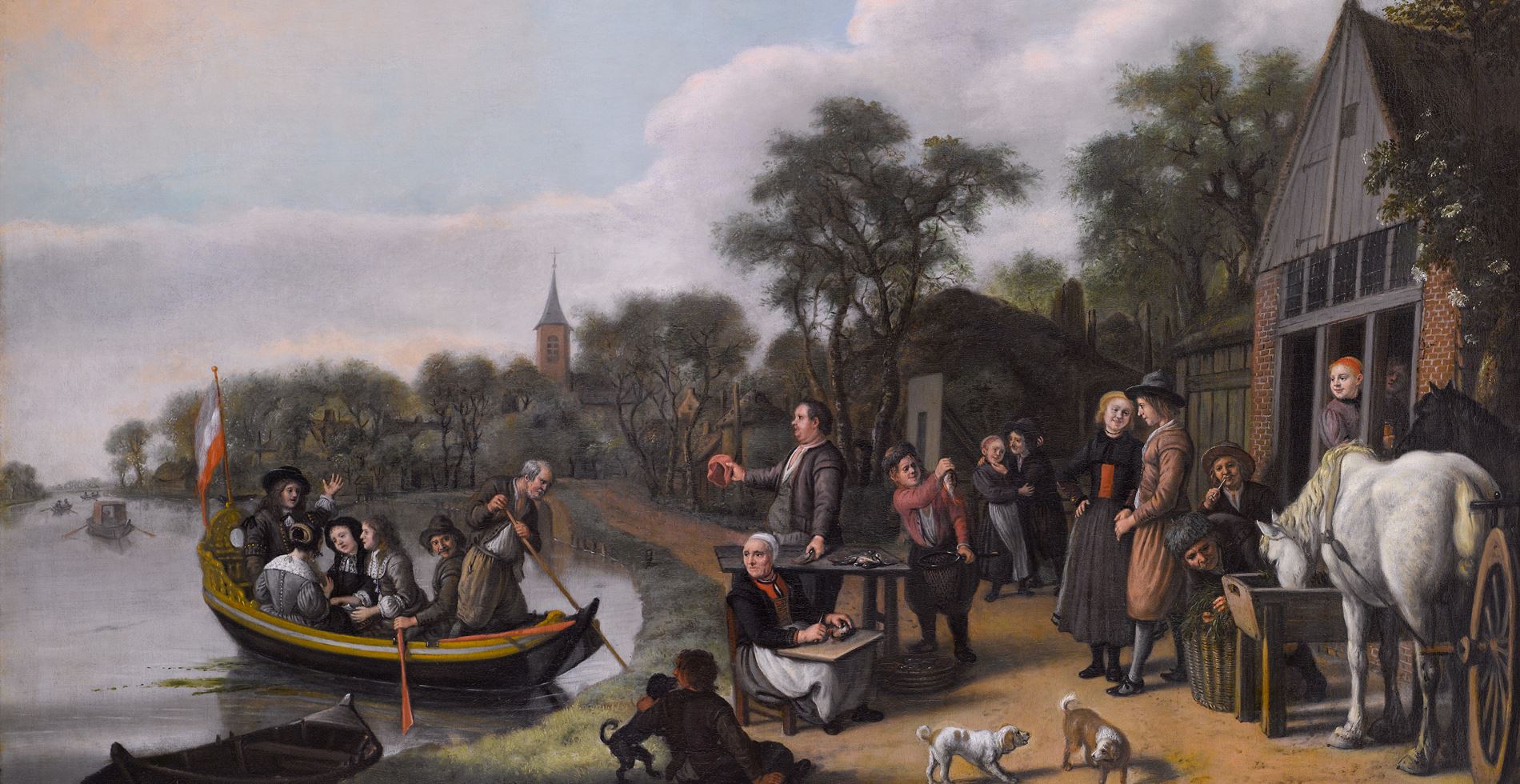
 contact
contact +44 20 7313 8040
+44 20 7313 8040


